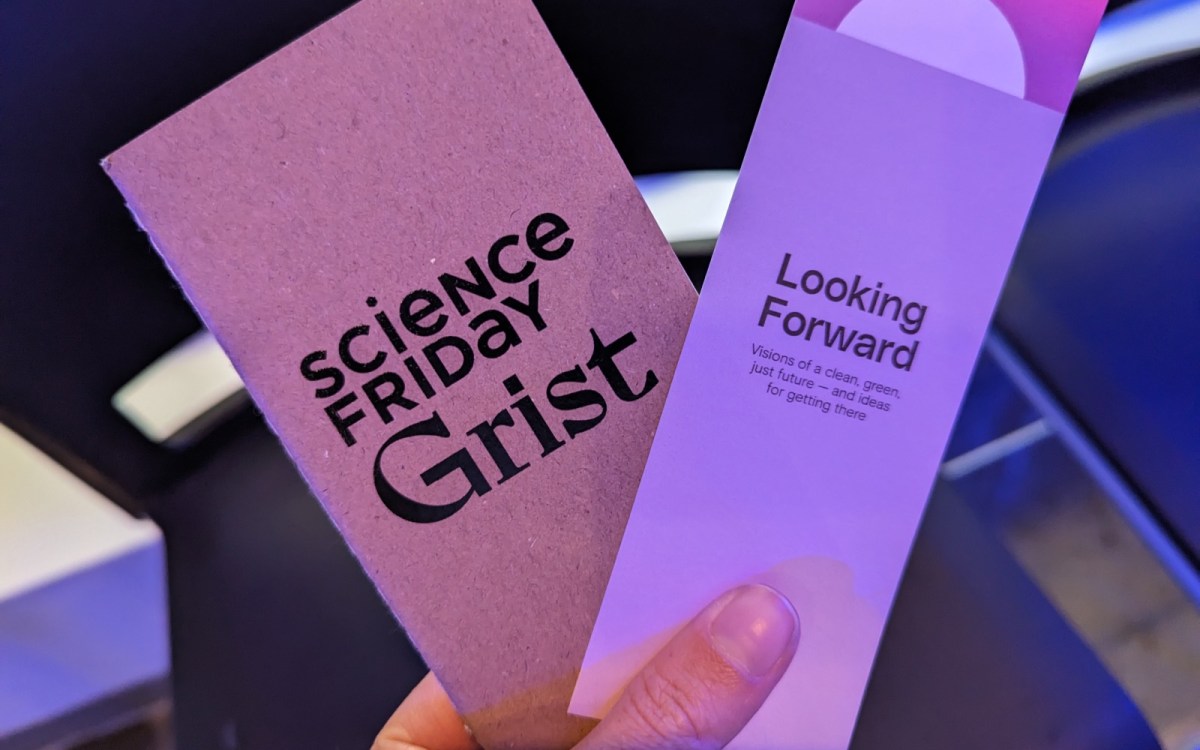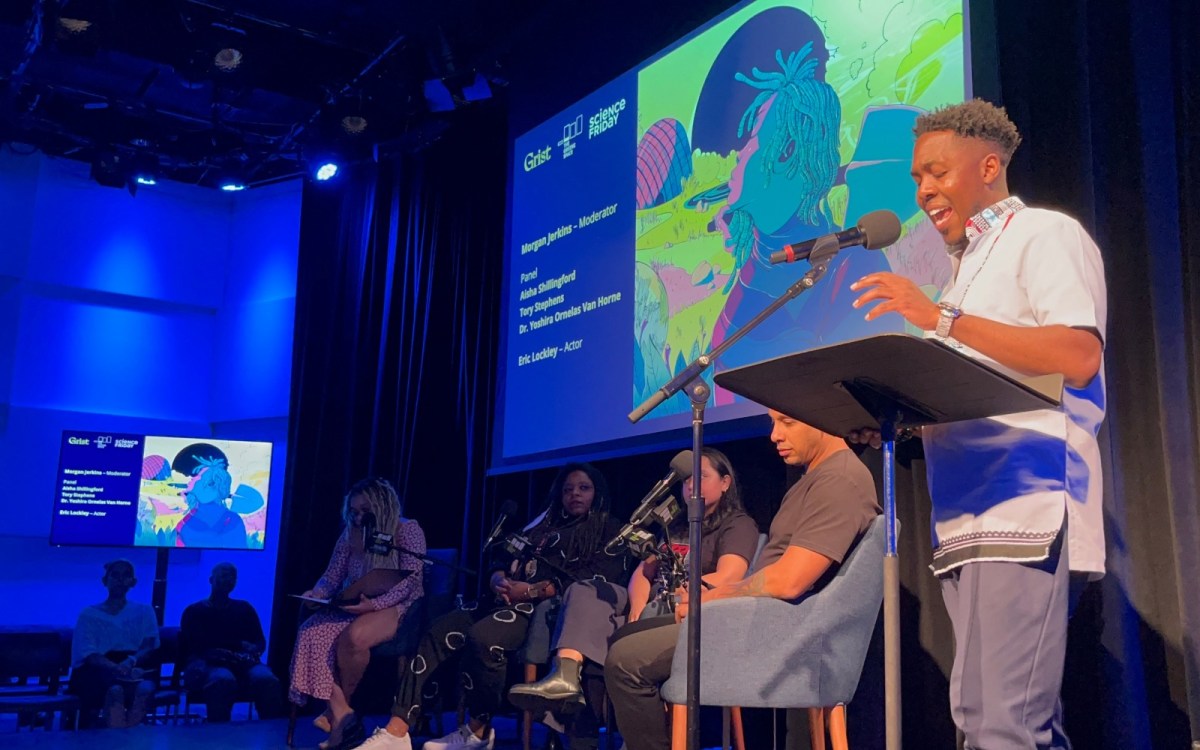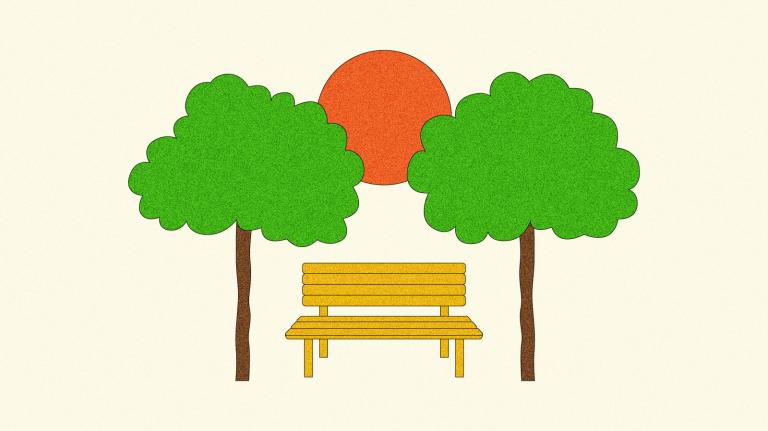
The spotlight
Hi, Looking Forward fam! Two nights ago, we had our very first LIVE book club event at Climate Week NYC, in partnership with Science Friday. This has been a particularly exciting book club for us, because we’re exploring Afterglow: Climate Fiction for Future Ancestors, the collection of winning short stories from Grist’s inaugural Imagine 2200 writing contest.
If you weren’t able to join us in person or tune in for the livestream, you can check out a recording of the event here. (Also, you can still RSVP for our community discussion — we’ll gather next Thursday, September 28, on Zoom! And we’re excited to be joined by the SciFri book club for that event as well.)
At our New York event, we got to hear from scientist Yoshira Ornelas Van Horne, artist and strategist Aisha Shillingford, and Grist’s climate fiction creative manager Tory Stephens in a fascinating panel moderated by bestselling author Morgan Jerkins.


The panelists explored the importance of imagining a radically different future, and how they apply this practice in both art and science.
Ornelas Van Horne, who does research with frontline communities, explained that she views environmental justice as a sort of shared vision — in the face of injustices that plague communities on the front lines of climate change and polluting industries today, environmental justice is the dream that the world could be different. “We envision that everybody will have clean air, clean water,” she said.

In between panel segments, we also enjoyed live readings from three stories in Afterglow, by Afrofuturist writer and actor Eric Lockley. (If you have the book at home, he read portions from “The Case of the Turned Tide,” “Broken from the Colony,” and “The Cloud Weaver’s Song,” which the panelists then discussed.)

To close out the event, Shillingford guided us all in a world-building exercise to imagine a resilient future for places that are meaningful to us, inviting everyone in the room to spend time envisioning a location they love in the year 2200. We’ve shared that visioning exercise below, for you all to try out at home.
As Shillingford told me after the event, world building is an opportunity to imagine how you construct a society on top of a set of values. Sci-fi and fantasy fans will know that it’s a concept often used by fiction writers and game designers to craft the world in which their story or game takes place, but Shillingford has found that it has real-life applications for social movements as well. In the context of sustainability, you’re trying to imagine the world that you desire for future generations — whether that’s your own direct descendants, or people who will live in a place that you are impacting today.
“You have to tell a story,” Shillingford said. If you want to build a sustainable world hundreds of years from now, it has to start as a vision — there are too many unknowns to simply plan a way forward. You need to begin with a story of how that future world functions, and then work backward to imagine the progress necessary to create it. This type of world building, she explained, allows us to temporarily suspend the reality of most of the obstacles that we face currently, so that we can identify potential core practices and experiments that we can implement right now. “When we do world building, we ask ourselves, ‘What if?’ and, ‘Why not?’”
— Claire Elise Thompson
See for yourself: Try this visioning exercise, courtesy of Aisha Shillingford
The exercise begins with some food for thought, and then invitations to record your thoughts in writing. (If you’d like to hear it real time, in Shillingford’s soothing voice, you can skip to 1:01:50 in the video recording.) And please, reply to this email to share what you envision!!
If folks are interested, we can continue the discussion at our community book club event next week. Remember to RSVP here.
![]()
1. Start with a few deep breaths.
2. Imagine that you are able to travel to a land that you love deeply. Bring to mind a place that you have a lot of affection for. A place that carries a lot of beautiful and good memories. A place that you feel connected to and a place that you feel loved by. Maybe it’s a land that has shaped you and who you are.
3. As you bring to mind an image or a memory from this land, send some gratitude to the ancestors of that land. The people who stewarded that land before you arrived at it, in a way that allowed you to enjoy it.
4. Imagine arriving at that land in the year 2200. Imagine that as you arrive in this place that you love, 177 years from now, that there are still people there. And they are thriving. And they are living in an equally thriving ecosystem. Take a few minutes to take it all in.
5. Record your thoughts, or what you’re seeing.
6. Write it down — what’s the name of the land that you chose to visit? What was its name when you were in relationship to it? And what might be its name in the year 2200?
7. What does that ecosystem look like? What do you smell, what do you hear, what do you feel? Who is on that land, and what are they doing?
8. As you observe this land in the year 2200, what values do you see shaping the ways of life in that community, on that land? What shared practices are making it possible for everyone to thrive? What structures or systems exist to make this thriving possible?
9. Then discuss (or share with us) — What did we do differently now, as future ancestors, to make that world possible for our descendants to thrive within? What leaps did we make? If there’s something you already have in mind, a huge transformation that seems impossible, imagine for a moment that it is possible. There’s no obstacle, there’s nothing in the way.
10. What role did you play in that leap? What gift of yours did you offer? How did you choose to step into your leadership as a future ancestor?
More exposure
- Read: a roundup of other Climate Week goings on, including massive protests demanding more decisive climate action from world leaders (Washington Post)
- Peruse: more Climate Week events happening over the next several days, many of which are free and some of which include livestream options
- Read: a fun and interesting story about how siestas — a Mediterranean tradition involving a big meal and a nap in the middle of the day — could be a climate adaptation (Grist)
- Read: another one about the science of sweating, our body’s best defense against extreme heat (Grist)
A parting shot
We had one more fun Climate Week event last night — an evening of live storytelling with some of the visionaries from this year’s Grist 50 list of climate leaders to watch.




